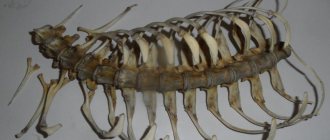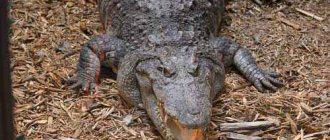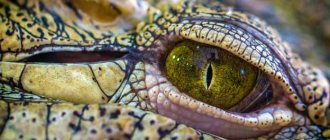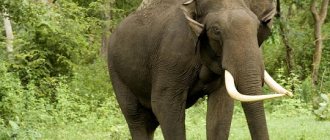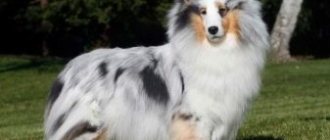Many people think that alligators and crocodiles are names for the same animal, used on different continents. But in fact, crocodiles and alligators, as well as caimans and gharials, belong to different families and have a number of differences, which we will talk about today.
The order of crocodiles (lat. Crocodylia) includes three families: true crocodiles, alligators and gharials. The alligator family, in turn, includes the alligator genus and the caimans genus. All crocodiles are secondary aquatic animals that, during the course of evolution, moved to water bodies from land. Representatives of this order are among the most ancient animals, whose ancestors appeared on Earth about 85 million years ago, back in the Cretaceous period, and were contemporaries of dinosaurs. Crocodiles live in warm tropical waters throughout the planet. They can be found in abundance in South America, Africa, India, on the continental and island territories of Southeast Asia, as well as in the north of Australia.
Some differences between alligators, true crocodiles and caimans are visible to the naked eye.
Salt glands of crocodiles
One of the most interesting differences between crocodiles and alligators is the presence of salt glands in the former. Crocodiles have functioning salt glands on their tongues, which are slightly visible when they bask in the sun with their mouths wide open.
The crocodile's salt glands are modified salivary glands that allow the crocodile to secrete large amounts of salt into the environment. Crocodiles are better adapted to salt water than alligators. It is assumed that this feature helped them spread throughout the world.
Interesting Facts
- The ancient Egyptians worshiped the god Sobek, who was associated with the Nile crocodile. He was prescribed fertility, power and protection of the pharaoh. The attitude towards the crocodile was twofold: crocodiles were often hunted for tasty meat and in this case they insulted Sebek, sometimes they saw him as a protector and source of power for the pharaoh. Sebek was compared with the earth goddess Hebe, the sun god Ra and Osiris. He was depicted as a crocodile, a crocodile mummy, or a man with the head of a crocodile. The center of his cult in the Middle Kingdom was the city of Shedit, which the Greeks called Crocodilopolis, and even later Arsinoe. Another major temple of Sebek was located in the city of Kom Ombo, and many smaller ones were located in many other cities of Egypt, mainly in Upper Egypt and the Nile Delta.
Caiman - On the island of Madagascar, the Malagasy people worship a local subspecies of the Nile crocodile. Crocodiles are kept in special “sacred lakes” under the protection of a religious taboo - “fadi”. Such a lake is, for example, Aniwuranu, located between the cities of Ambilube and Diego Suarez. During religious festivals, domestic animals such as goats or chickens are sacrificed to crocodiles.
- In Nepal and India, the gharial is a sacred animal. One of the problems of gharial conservation is to revive the people's respect and respect for this ancient animal. To achieve the needs of local people living near gharials, gharial conservation actions must be mutually beneficial to people and nature. Because gharials eat fish, they are often blamed for declining fish populations, or seen as food competitors, and are therefore killed.
Gharial muzzle - There is an ancient legend that a crocodile, eating its prey, cries “crocodile tears”, mourning it. In fact, crocodiles do not “cry” out of pity. It's all about an excess of salts in the body, to remove which real crocodiles have special glands that open outward near the eyes. Thus, “crocodile tears” are a protective reaction of the body aimed at removing excess salts.
Natural habitat
Since alligators cannot tolerate salt, they prefer freshwater habitats, while crocodiles are able to live in salt water. Compared to crocodiles, which are widespread throughout the world, alligators live only in the USA and China.
In the United States, alligators are common in the southeast of the country, while in China they are limited to the Yangtze River valley. Crocodiles are usually found in wetlands, rivers, lakes, and salt water bodies. They also prefer tropical climates as they are cold-blooded animals and cannot generate heat on their own.
Teeth
Representatives of the family of true crocodiles have 64-68 sharp teeth, which are visible when the mouth is closed, among them the fourth tooth on the lower jaw is especially prominent. But this is not observed in alligators; they have 74-80 teeth, depending on the species, and when their mouths are closed, their teeth are not visible.
Baby animals
Let's start with pets. They catch the eye of children more often, and therefore arouse greater interest.
Sheep
Let's look at what a baby sheep is called. Many people living in cities do not even realize that sheep and ram are one type of animal, only female and male. Their baby is not called a ewe or lamb, but a lamb.
Pig
Pigs are one of the first animals to be domesticated by humans. They belong to the order Artiodactyls. They supply people with meat and lard. The female pig is called a sow or pig, and the male is called a boar or boar. But their baby is called not a pig or a hog, but a piglet.
This is interesting! The Slavs called a male pig a poros. The addition of the suffix “enok”, again, means a reduced form. Hence the name - piglet.
By the way, the birth of piglets is called farrowing, and a pregnant pig is called gestation.
Cow
Cows have been tamed by humans since ancient times. They give people meat and milk. The male cow is called a bull, and the baby is called a calf. Another example of the fact that children and parents have different roots.
Experts still cannot figure out where the word calf came from; there are only guesses. One of them is that among the ancient Slavs this word meant “born”, but cows bear their offspring for 9 months.
Turkey
America is the homeland of turkeys. But in recent centuries, this bird has been grown in European countries.
This is interesting! Few people know that turkeys are named after their homeland. Previously, America was called the West Indies, so the name of the birds is translated as Indian rooster.
In this case, parents and their children have the same root. A female turkey is called a gobbler or turkey, and her baby is called a poult.
Rabbit
Another domestic animal is the rabbit. The female is called a rabbit, the male is called a rabbit, and their baby is called a bunny.
Scientists also test drugs on rabbits before releasing them for sale. Not long ago, dwarf breeds of rabbits were bred; now they are kept in apartments instead of hamsters and guinea pigs.
Goats
Unlike previous animals, goats are not so often raised by people, but there are entire farms with them. The fact is that in addition to meat and fatty milk, these animals provide people with skin and wool.
The female of these animals is a goat, the male is a goat, and their baby is a kid. The baby’s name still contains the same “diminutive” suffix “enok”.
Many people confuse kids with lambs. This is a big misconception because we are talking about two different species of animals.
Horses
Horses were domesticated more than 7,000 years ago. During this time, people developed many breeds of these animals, from miniature ponies to huge draft horses and horses.
A female horse is called a mare, a male is called a stallion or horse, and their baby is called a foal. If we are talking about two or more babies, then the word foals is used.
Speaking in general about this type of animal, two names are applied to them: horses and steeds.
Ducks
Ducks can be wild or domestic. They belong to the order of birds and are valued for the taste of their meat. The female of these birds is called a duck, mallard, the male is called a drake, and their baby is called a duckling. If we are talking about two or more chicks, then the word ducklings is used.
Best articles: Characteristics of the climate of Africa - map, types and climatic regions
We looked at domestic animals, but there are many more wild and tropical animals, as well as fish and birds, that are of interest to children and adults.
Very often children ask: what is the name of a baby zebra or giraffe? But not every adult will immediately answer this question.
Zebras
Zebras belong to the order of equids. In fact, these are the same horses, only with a characteristic black and white coloring. In common parlance, zebra cubs are called baby zebras or baby zebras, but this is an incorrect endearing interpretation. The correct name is foal, just like horses.
Giraffe
Since giraffes are the tallest animals in the world, interest in this animal is high. With their participation, many cartoons were shot, various stories and fairy tales were invented. It is not surprising that children are interested in the question: what is the name of a baby giraffe?
Since these representatives of the fauna belong to the order of artiodactyls, their babies are called calves. However, this name was not strongly attached to the offspring of giraffes. They are more often called giraffes or giraffes. But if a child is given the task of describing baby giraffes, then the correct word would be a calf.
Character and nutrition
It is believed that true crocodiles are more aggressive than alligators or gharials, for this reason they are able to defeat very large prey and often attack people. But gharials, with their narrow, one might say graceful by crocodile standards, snout, cannot defeat large prey and are content with small animals.
Reproduction
The female lays eggs on the shore, digging a hole in the sand or among rotting plants. The masonry is covered on top with a mixture of earth, grass, and leaves, which rot and warm the eggs. Before emerging from the eggs, the babies call for their mother. She helps them leave the shell and carries them in her mouth to the nearest body of water.
The sex of crocodiles depends on the temperature in the nest. At a temperature of 34 °C males will hatch, at 30 °C - females, in the intermediate variant - both sexes.
Rice. 2. Crocodiles eggs with babies.
general characteristics
All crocodiles are semi-aquatic predatory animals.
They have a powerful, elongated body and a flattened muzzle. The location of the ears, eyes and nostrils on the upper surface of the head allows them to stay in the water for a long time. The strong tail, compressed laterally, serves as a rudder during swimming. Strong paws located on the side of the body ensure fast movement on land.
Reptiles have thick skin covered with horny plates. Crocodiles do not shed; their skin wears out and is gradually renewed.
Predators watch for prey near watering holes, hiding under the water, with their eyes and nostrils exposed above the surface. To attack, they can “jump” high above the water and run ashore. If necessary, they set up an ambush among the coastal bushes. Prey is consumed underwater. Sometimes they make underwater caches in driftwood where they hide the remains of the carcass.
Rice. 1. Nile crocodile.
Range and number of species
Real crocodiles are the most prosperous representatives of the order. There are 14 species of them, they live on the American continent, have sole control over Africa, where besides them there are no other representatives of the genus of crocodiles, and also inhabit Southeast Asia and Australia. As we already know, there are two genera in the alligator family: alligators and caimans. The alligator genus includes the American alligator, found in the southern United States, and the very rare Chinese alligator, found in the Yangtze basin. And all three species of the caiman genus live in Central and South America. Gharials, of which there are only 2 species, during the division of the world only India and the islands of Southeast Asia went to.
The material is copyrighted; when copying, a link to the article or the website travelask.ru is required
Lifestyle
Crocodiles eat any food they can handle, be it fish, small or large mammals. Crocodiles hunt mainly at night. They can survive without food for a long time; there have been cases where a crocodile lived without food for a year and a half. Such a high survival rate was achieved thanks to fat reserves, because more than 60% of the food that a crocodile eats goes into the fat layer.
Alligators prefer to eat fish, but sometimes they can get a small mammal for lunch. Alligators are resistant to falling temperatures and survive even when the thermometer drops below zero. If the temperature returns to normal, the alligators return to their usual (nocturnal) lifestyle.
